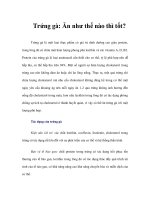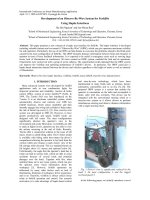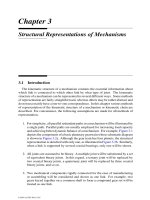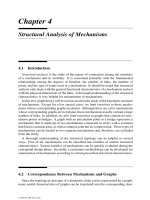Tài liệu IDENTIFICATION OF AN UNKNOWN ORGANIC COMPOUND: Classification Tests ppt
Bạn đang xem bản rút gọn của tài liệu. Xem và tải ngay bản đầy đủ của tài liệu tại đây (62.82 KB, 6 trang )
IDENTIFICATION OF AN UNKNOWN ORGANIC COMPOUND
Classification Tests
In this experiment you will attempt to identify an organic unknown from a selected group
of compounds from the class of alcohols, aldehydes, ketones, carboxylic acids, phenols,
or amines. You will use physical properties (mp, bp), solubility characteristics and
functional group tests to identify your unknown from a list of possible compounds.
Physical Properties:
Note the physical state and color of the compound. Determine the melting point or
boiling point depending on the physical state of the compound. Make sure boiling point
apparatus in under the snorkel hood to prevent fumes from entering the working area.
Solubility Classification:
An organic compound is generally considered soluble if ~0.2mL of a liquid or
~0.1g of solid dissolves completely in 3mL of the appropriate solvent. Determine the
solubility of your unknown in the following solvents and compare your sample to the
solubility characteristics of the various classes of organic compound. Remember, these
are general rules-there may be exceptions depending on other functionalities in the
molecule.
Solvent Characteristics
Soluble in Water
Lower members of homologous series of O
or N containing compounds (alcohols,
ketones, amines, carboxylic acids, amines
having <5 C atoms
Insoluble in water but soluble in 5% NaOH
and 5% NaHCO
3
Carboxylic acids with 5 or more carbons,
phenols with electron withdrawing groups
and β-diketones
Insoluble in water, insoluble in 5%
NaHCO
3
, but soluble in 5% NaOH
Phenols
Insoluble in water, insoluble in 5% NaOH,
5% NaHCO
3
, but soluble in 5% HCl
Amines
Solubility Test Procedure:
Water: Place 0.1g of powdered solid in a small test tube and add 3 successive 0.1mL
portions of water. Shake the sample after each addition of water. If the solid does not
appear to dissolve, warm the test tube. If the solid dissolves, cool the sample to room
temperature. If the solution remains homogeneous, the sample is considered to be
soluble.
For a liquid, add 0.2mL to 3.0mL water. Shake and observe whether two phases
result or a homogeneous solution. The presence of two phases indicates an insoluble
sample. Do not heat.
Solubility in 5% NaOH: Proceed as above but do not heat. Note whether there is an
increase in temperature or any sign of reaction. If the unknown does not appear to
dissolve, it is probably a negative test. However, it may be that the sodium salt that
forms has only limited solubility. If in doubt, remove some of the aqueous (without
solids) and place in a small test tube. Add dilute HCl dropwise until litmus paper shows
an acid solution. If any solids appear, assign the sample as “soluble in 5% NaOH”.
Solubility in 5% NaHCO
3
Proceed as for water, but do not heat. Observe whether any
bubbles appear, indicating the formation of CO
2
, which is characteristic of a reaction with
a carboxylic acid or phenol with an EWG.
Solubility in 5% HCl: Proceed as for water, but do not heat. Note any temperature
increase or any other sign of reaction. If the sample does not appear to dissolve, it is
probably a negative test. If in doubt, remove some aqueous sample (without solids) and
place in a small test tube. Add dilute NaOH until the sample is basic to litmus. If any
solids appear assign to compound “soluble in HCl”.
Use the following chart to give a preliminary classification to your unknown
Group A
Lower members of homologous series of O
or N containing compounds (alcohols,
ketones, amines, carboxylic acids, amines
having <5 C atoms
Group B
1
Carboxylic acids with 5 or more carbons,
phenols with electron withdrawing groups
(more acidic) and β-diketones (more
acidic)
Group B
2
Phenols
Group C
Basic compounds (amines)
Group D
Hydrocarbons, alkyl halides, highly
alkylated (containing 5 or more carbon
atoms) alcohols, aldehydes, ketones.
If you determine you compound is Group A, test the pH of the solution with pH paper. A
pH < 3 is indicative of a carboxylic acid or phenol. A neutral pH is indicative of an
alcohol, aldehyde, or ketone. A basic pH is indicative of an amine.
Functional Group Tests:
Test for unsaturation-Rxn with Br
2
: Knowns: Add 0.2 g of the known sample (to be
provided) in 2 mL of methylene chloride. Add the bromine solution dropwise until the
red color remains after shaking or until 25 drops have been added. Note any color
change. Place a piece of moist litmus paper (blue) in the vapor space and note any
indication of HBr, which would indicate a substitution reaction instead of addition.
water
soluble
insoluble
NaOH
NaHCO
3
HCl
soluble
insoluble
insoluble
soluble
insoluble
soluble
Group A
Group B
1
Group B
2
Group C
Group D
Test for unsaturation-Rxn with KMnO
4
: Dissolve the sample to be tested in a minimal
amount of water or acetone (up to 2 mL). Add the reagent as in the previous test. The
formation of a brown colored solid indicates a positive test. It is sometimes helpful to
place a drop of the mixture on a piece of filter paper to more easily observe the brown
color.
Test for Organic Acids: Add 5 drops or 0.1g of a known carboxylic acid (provided) to a
small test tube containing ~2mL of 5% NaHCO
3
. The evolution of a gas is a positive test
for an organic acid.
Test for Aldehydes and Ketones: Place approximately 1g 2,4-dinitrophenylhydrazine
in a 150mL Erlenmeyer flask and add 50mL isopropanol (isopropyl alcohol, IPA). Add
1mL of the unknown and heat until the solvent boils. Remove from heat and add 1.5mL
conc. HCl. Reheat to a boil for 5 minutes. Remove from heat and allow the solution to
cool 5 minutes. Place the solution in a ice bath and chill for 5-10 minutes. The formation
of yellow/orange to red crystals is a positive test for aldehydes or ketones. The crystals
may be isolated by filtration and washed with ~5mL cold isopropyl alcohol (IPA). Suck
dry and dry in an oven until dry.
Tollens Test: The Tollen's reagent is fairly unstable and must be made fresh before
using. To do this, place 1 mL of 5% AgNO
3
in a clean test tube. Add 1 drop of 10%
NaOH and then 2-4 drops of concentrated NH
4
OH until the silver oxide dissolves. Add
1-2 drops of your unknown to your freshly prepared reagent. The formation of a silver
mirror or black precipitate constitutes a positive test, which is indicative of an aldehyde.
The silver will deposit so as to form a mirror only on a clean glass surface. If no reaction
occurs at room temperature, warm the solution slightly in a beaker of warm water.
Fehlings Test: This test is similar to Benedict’s solution in that Cu
+2
is used to oxidize
an aldehyde. Add 1mL Fehling solution A to 1mL Fehling solution B. Add 2-4 drops of
sample (0.1g) and heat the mixture in hot (90-100
o
C) water for 5 minutes or until the
formation of a precipitate or color change occurs.
Jones Oxidation: Oxidation with Dichromate This test shows a positive reaction with
primary and secondary alcohols. Upon oxidation the orange dichromate is reduced to the
green-blue of the Cr
+3
ion. Tertiary alcohols do not react. To each of four test tubes, add
2 ml of 1% sodium dichromate and 5 drops of concentrated sulfuric acid and mix. Then
add 10 drops of the primary alcohol to the first tube, 10 drops of the secondary alcohol
to the second tube,10 drops of the tertiary alcohol to the third tube, and 10 drops of
your unknown to the fourth tube. Mix and warm the test tubes in a 40-50 deg water bath
for one minute. Record any color changes.
Lucas test: The Lucas reagent is a solution of zinc chloride in concentrated hydrochloric
acid. Alcohols are differentiated by the rate of reaction with the the Lucas reagent to form
an alkyl chloride. Tertiary alcohols react immediately and form a cloudy solution.
Secondary alcohols usually react to form a cloudy solution in five minutes, and primary
alcohols do not react at room temperature. To each of four test tubes, add 5 ml of the
Lucas reagent. Add 1 ml of the primary alcohol to one, 1 ml of the secondary alcohol to
the next, 1 ml of the tertiary alcohol to the third, and 1 ml of your unknown to the fourth
test tube. Mix with a stirring rod. If the secondary alcohol does not visibly react, heat it in
a 40-50 deg water bath for 30 seconds. Record any color changes.
Iodoform Test: To each of four test tubes, add 1 ml of the primary, secondary, tertiary,
and unknown alcohol respectively. Add 1 ml of water to each, and 1 ml of 10% NaOH,
and 1.5 ml of the iodoform reagent (0.5 M KI/I solution). Mix and record your
observations. A positive test is the disappearance of the brown color and the formation of
a yellow precipitate. Both of these conditions must be met in order to consider the
reaction a positive test. A positive test indicates a methyl group on the carbon bearing
the carbonyl or hydroxyl group.
Test for 1
o
and 2
o
amines: For the known sample, use aniline or N-methylaniline. Place
5-8 drops of acetyl chloride in a small test tube (caution: acetyl chloride is a
lachrymator(eye irritant). Use under a hood. Keep the sample container capped when
transporting from the fume hood to the snorkel hood). Add 10-12 drops of the sample
and observe any signs of reaction. The formation of a white solid or a white vapor trail is
indicative of an amine. On completion of the test slowly pour the contents of the test
tube into a beaker containing 10-20mL of NaHCO
3
solution.









